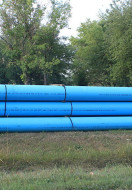There are more than 160 different species of Aspergillus, 16 of which have been documented as etiological agents of human disease.
The aspergilli are probably the most common group of fungi in our environment. Many species of the genus are frequently isolated from a variety of substrata, including forage products, grains, nuts, cotton, organic debris and water damaged organic building materials.
Because of the ubiquity of the aspergilli within the environment, man is constantly exposed to these fungi. The diseases caused by species of Aspergillus are relatively uncommon and are rarely found in individuals with normally functioning immune systems. However, due to the substantial increase in populations of individuals with active immune suppression, such as individuals with HIV, chemotherapy patients and those on corticosteriod treatment, contamination of building substrates with fungi, particularly Aspergillus species have become an increasing concern. Aspergillosis is now the second most common fungal infection requiring hospitalization in the United States.
The most frequently encountered opportunistic Aspergillus pathogen, Aspergillus fumigatus, is seen most abundantly in decomposing organic materials. Because it grows well at temperatures up to 55 degrees, self-heating compost piles provide an excellent environment for the fungi. Compost made up of chipped branches and leaves will often yield a massive and virtually pure culture of fumigatus has been reported to be the major organism isolated from air samples obtained near compost sites. People who handle compost or decomposing haystacks often develop hypersensitivity to spores of Aspergillus and after exposure may suffer a severe allergic response.
Aspergillus flavus is the second most frequently encountered fungi in cases of infection with Aspergillus species. In addition to causing infections, Aspergillus flavus is also renowned for its production of aflatoxin, one of the most potent carcinogens known to man. Concern about aflatoxin began in the 1960s after some 100,000-turkey poults in Great Britain died as a result of ingesting feed tainted with aflatoxin. When it became evident that aflatoxin was highly carcinogenic most industrialized countries established tolerances for aflatoxin levels in food and feeds. The risks associated with airborne exposure to aflatoxin in contaminated buildings, as with other mycotoxins,
has not been adequately studied.
Aspergillus niger is the third most common aspergilli associated with disease and is more common than any other Aspergillus species within the genus and is found in and upon the greatest variety of substrates. It is commonly associated with "fungus ball", a condition wherein fungus actively grows in the human lung, forming a ball, without invading lung tissue.
Because invasive aspergillosis occurs most frequently among highly immunosuppressed patients, the presence of Aspergillus spores in hospital air has important implications. Aspergillus spores frequently occur in hospitals throughout the world and a number of severe outbreaks resulting in deaths due to disseminated invasive aspergillosis have been reported following renovation activities in hospitals.
A study of 39 bone marrow transplant patients who resided in rooms equipped with whole wall laminar flow HEPA filtration units reported no cases of nosocomial aspergillosis. In sharp contrast, 14 cases of nosocomial aspergillosis in 74 bone marrow transplant recipients occurred in-patients housed elsewhere. It is critical that adequate engineering controls are implemented during renovations at hospitals or at any facility the immunosuppressed frequent.







